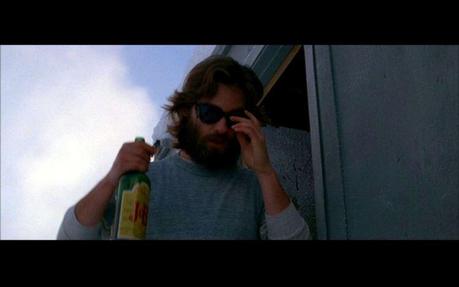“As a whole the subjects became less trusting and more suspicious of others immediately after their year in Antarctica.” –A.J.W. Taylor, Professor of Clinical Psychology, “The Selection of People for Work in Polar Regions”

John Carpenter’s The Thing (1982) opens on a U.S. Research Base with a small winter crew, none of whom appear to be scientists. The main character is an independent and quirky drunk named MacReady (played by a bearded Kurt Russell who looks like Ernest Joyce from the Aurora expedition of 1915-1916). “Mac”, as he is called (the real McMurdo Station is often called “MacTown”), wears a beat-up sombrero (the “frontier” allusions are bolstered with a soundtrack by Ennio Morricone, who did the music for the Clint Eastwood spaghetti westerns). In the opening scene, Mac is playing chess on a computer. The computer swiftly beats him and he responds to the intellectual trouncing by pouring J&B whiskey, ice included, into the computer’s circuitry.
Some commotion takes the men outside, where an apparently insane Norwegian in a helicopter is trying to shoot a dog running toward the U.S. camp. No other country has consistently proven itself so competent in Antarctic endeavors as the Norwegians, yet the foreigner cannot kill the dog with a high-powered rifle. When he tries to kill the dog with a grenade, it slips from his hand and destroys the helicopter. The Americans shoot him and lay his body out on the pool table. After they put the dog in the kennel, the dog turns into a terrible tentacled monster that sprays the other dogs with a corrosive digestive acid, and thus begins a nightmareish, paranoid ordeal, on par with Invasion of the Body Snatchers (1956).

On casual viewing, The Thing appears to be just another classic sci-fi movie with somewhat dubious special effects. However, no other movie in history has ever depicted daily Antarctic life and its problems with such accuracy and intuitive brilliance. It takes place in a research station with no scientists, which is the case with McMurdo Station in the winter (the McMurdo research station is in fact referenced during the film). The doctor character in the film was insane, which underscores the problem of attracting qualified physicians who have no practice at home and who are willing to work for peanuts on year-to-year contracts in Antarctic stations. The doctor was then locked in a hut away from the others after his madness, much like the kitchen worker who was locked in McMurdo’s luxurious Hut 10 to await retrieval by the FBI after attacking his co-worker with a hammer in 1996. There was rampant suspicion of aliens, which parallels the evacuation from McMurdo in November 2000 of a science tech who held a lecture called “The Reality of Dreams” and later advertised to the hoi polloi that one Thursday aliens would descend in spacecraft to meet him outside the galley. The testing of the crew’s blood brings to mind the USAP employee drug tests.
The Thing also prophetically dramatized, and served as propaganda for, the U.S. political push to ban dogs from Antarctica, which the other Treaty Nations reluctantly consented to in 1991. And what of “The Thing” itself, that can infect any fellow and turn him into a threat against his neighbor, and which leads to the ultimate downfall of “The Station”? The Thing represents Bureaucracy, reproducing via individual hosts who are each stunted by their fear of an organized but faceless entity that influences every aspect of their daily lives. If there is a more lucid film that describes daily Antarctic life, it has already crumbled to dust in obscurity.

Common icons of Antarctic life are repeated throughout the film with uncanny precision: spilled fuel; ubiquitous barrels; plentiful whisky; anti-intellectualism; resentment toward Norwegians (who were the first to Pole); general madness; obsession with generators; and black flags planted in the snow. There are minor annoyances, too, such as the crew storing dynamite in a supply closet in the main building, nothing is tied down outside to keep it from the wind, and their machines start up in the cold without being plugged in.
Of course the most noteworthy deviation from actual United States Antarctic Program practices is that in the film everyone has a flamethrower!

Nick Johnson 11/10/11
Johnson wrote Big Dead Place: Inside the Strange and Menacing World of Antarctica about life in Antarctica, where he worked on and off for ten years.

